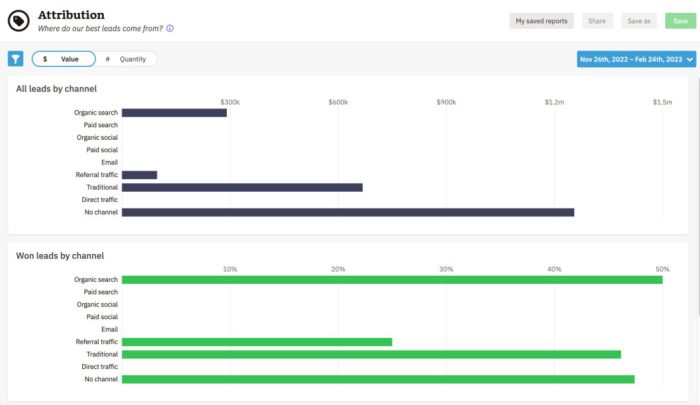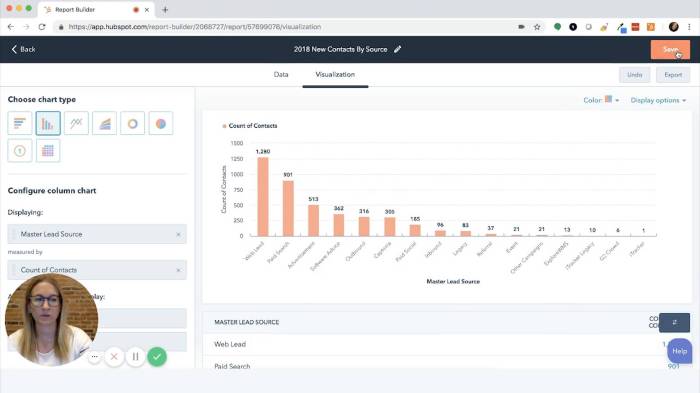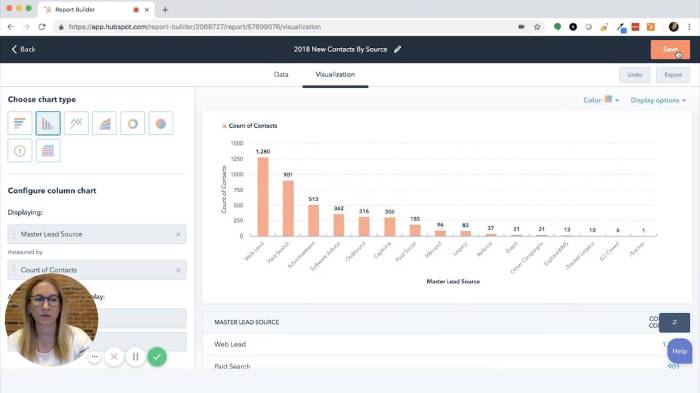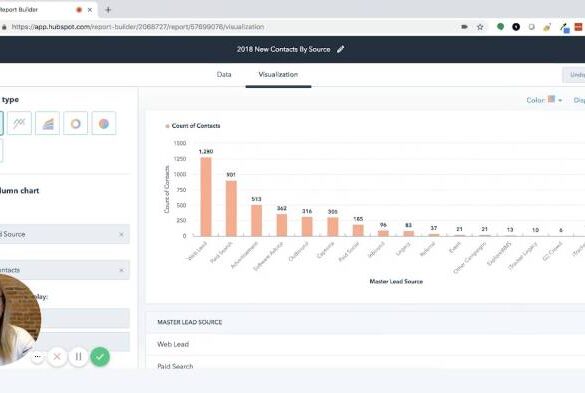Lead source attribution modeling is crucial for understanding where your leads are coming from and how effectively your marketing campaigns are performing. This process allows businesses to track the journey of a potential customer from initial contact to conversion, revealing which channels and strategies are most impactful. Imagine a business that wants to pinpoint the most effective marketing channels to allocate resources more efficiently.
This detailed exploration will delve into the methods, data, tools, and best practices behind successful lead source attribution modeling.
By understanding the different methods of attribution – like first-touch, last-touch, and multi-touch – businesses can gain valuable insights into the complex customer journey. We’ll explore the data sources required, potential challenges, and strategies for optimizing the process. This information will empower you to make informed decisions about your marketing efforts, leading to improved ROI and ultimately, greater success.
Introduction to Lead Source Attribution Modeling
Lead source attribution modeling is a crucial aspect of marketing and sales strategy, enabling businesses to understand which marketing channels are most effective in generating leads. It goes beyond simply identifying where leads originate, delving into the entire journey a lead takes before converting, identifying the touchpoints that ultimately contribute to a sale. This understanding allows businesses to optimize their marketing efforts and allocate resources more effectively.This detailed analysis of lead journeys reveals the relative importance of different marketing channels in generating revenue.
By tracing the influence of various sources, businesses gain a comprehensive understanding of the customer journey, allowing them to refine and optimize their marketing mix to maximize lead conversion rates. This deeper understanding also provides critical insights for improving the efficiency of marketing campaigns.
Significance in Marketing and Sales Strategies
Lead source attribution modeling plays a vital role in refining marketing and sales strategies. By pinpointing the most effective channels, businesses can allocate resources more efficiently, concentrating their efforts on channels that yield the best results. This targeted approach minimizes wasted spending on underperforming channels and maximizes return on investment (ROI).
Benefits for Different Businesses
Businesses of all sizes and industries can benefit from lead source attribution modeling. Small businesses can use it to allocate limited marketing budgets more effectively, while larger corporations can refine complex multi-channel campaigns.
- Improved ROI: By understanding which channels are most effective in generating leads and conversions, businesses can optimize their marketing spend, ensuring a better return on investment.
- Enhanced Customer Journey Understanding: Attribution modeling reveals the sequence of touchpoints a lead experiences before conversion. This detailed view provides invaluable insights into customer behavior, enabling businesses to tailor their messaging and improve the customer experience.
- Data-Driven Decision Making: Attribution models provide quantifiable data on the effectiveness of different marketing channels. This data allows for more informed decisions regarding budget allocation, campaign optimization, and channel selection.
Illustrative Example
Imagine a hypothetical online retailer, “TechGear,” that utilizes various marketing channels, including social media ads, email marketing, and search engine optimization (). They want to understand which channel contributes most to converting online leads into paying customers.
| Lead Source | Touchpoints | Conversion |
|---|---|---|
| Social Media Ads | Click, Landing Page View, Product Page View, Add to Cart | Purchase |
| Email Marketing | Open, Click, Product Page View, Add to Cart | Purchase |
| Search, Product Page View, Add to Cart | Purchase |
TechGear could use attribution modeling to determine the exact contribution of each channel in the customer journey. For instance, an attribution model might reveal that while social media ads initially attract leads, email marketing plays a crucial role in nurturing those leads and driving conversions. , meanwhile, might be vital for driving consistent, organic traffic and brand awareness.
Methods of Lead Source Attribution: Lead Source Attribution Modeling
Understanding where your leads come from is crucial for optimizing marketing campaigns. Attribution modeling helps you pinpoint the touchpoints that ultimately result in a conversion, allowing you to allocate resources effectively and measure the true impact of different marketing channels. This crucial insight empowers data-driven decisions that improve your overall marketing strategy.
First-Touch Attribution
First-touch attribution models credit the very first touchpoint a lead has with your brand as the primary driver of conversion. This model is straightforward and easy to implement, as it focuses on the initial interaction. For example, if a lead first encounters your company through a social media ad and subsequently converts, the social media campaign is solely credited with the conversion.
Last-Touch Attribution
Conversely, last-touch attribution focuses on the final touchpoint before a conversion. This method is widely used because it seems intuitive, often aligning with the customer’s immediate decision-making process. However, this model may overlook the crucial initial interactions that ultimately led to the conversion.
Multi-Touch Attribution
Multi-touch attribution models recognize that conversions are rarely the result of a single touchpoint. They consider a series of interactions over a period of time, assigning varying degrees of influence to each touchpoint. This approach provides a more comprehensive view of the customer journey, giving a more accurate representation of the entire conversion process. Different multi-touch models exist, each with a unique weighting system for assigning credit.
Lead source attribution modeling is crucial for understanding where your leads are coming from, but it’s equally important to consider the human element. Jen VanAntwerp, in her insightful piece on building inclusive events in cybersecurity ( jen vanantwerp on building inclusive events community in cybersecurity ), highlights the importance of creating welcoming spaces for all. Ultimately, this translates back into better lead source attribution – a more diverse pool of potential customers will lead to a more robust understanding of the effectiveness of different marketing channels.
For instance, a model might use linear attribution, giving equal weight to each touchpoint, or a more complex model, such as time decay, which gives diminishing importance to touchpoints further in the past.
Comparison of Attribution Models
| Attribution Model | Description | Strengths | Weaknesses |
|---|---|---|---|
| First-Touch | Credits the first touchpoint with the entire conversion value. | Simple to implement and understand. Provides a clear starting point for understanding the customer journey. | Ignores subsequent touchpoints, potentially underestimating the value of other channels. May not accurately reflect the true impact of marketing efforts. |
| Last-Touch | Credits the last touchpoint with the entire conversion value. | Intuitive and often aligns with the customer’s immediate decision-making process. Easy to track and analyze. | Ignores the critical initial touchpoints and the value of prior interactions. Can be misleading, as the final touchpoint might be the least impactful in the overall conversion process. |
| Multi-Touch | Distributes conversion value across multiple touchpoints based on different weighting methods (e.g., linear, time decay, position-based). | Provides a more holistic view of the customer journey. Accurately reflects the contribution of various touchpoints. Allows for more nuanced marketing campaign analysis. | Requires more complex modeling and data analysis. Different models may produce different results, requiring careful selection. |
Data Sources and Considerations

Lead source attribution modeling relies heavily on data. The quality and comprehensiveness of the data directly impact the accuracy and reliability of the model’s output. Understanding the various data sources available and the challenges associated with them is crucial for building a robust and effective attribution model. A thorough understanding of data sources, potential biases, and cleaning strategies is paramount for meaningful insights.
Types of Data Required
The core data needed for lead source attribution modeling typically encompasses website analytics, CRM data, and marketing campaign data. Website analytics provide insights into user behavior on the website, including landing pages, time spent on site, and interactions with specific elements. CRM data offers details about customer interactions, including contact history, purchase history, and demographics. Marketing campaign data captures information about the channels used to reach potential customers, such as email marketing campaigns, social media ads, or paid search campaigns.
Each data source offers a unique perspective, and the combination of these data sets allows a more comprehensive understanding of the customer journey.
Data Source Access and Integration Challenges
Gathering and integrating data from different sources can present significant challenges. Data silos within organizations often impede seamless access to crucial information. Data formats may vary across different systems, creating compatibility issues during integration. Privacy regulations and security concerns can also restrict access to sensitive customer data. Furthermore, ensuring data consistency and accuracy across diverse sources is critical for reliable analysis.
In some cases, data may be incomplete or missing, hindering the effectiveness of the attribution model.
Data Cleaning and Preparation Strategies
Before any analysis, data cleaning and preparation are essential steps. This involves handling missing values, correcting inconsistencies, and transforming data into a suitable format for analysis. For example, standardizing date formats, resolving conflicting data entries, and handling outliers are crucial steps. Cleaning processes should also identify and address any potential errors or inconsistencies in the data. A crucial step is data validation to ensure the quality of the cleaned data.
Understanding lead source attribution modeling is crucial for marketers, but equally important is the impact of design on SEO and user experience. A well-designed website, as detailed in the significance of design in seo and user experience , directly affects how users interact with your site, ultimately influencing the effectiveness of your lead source attribution model. Ultimately, understanding the interplay between design and attribution is key to optimizing your marketing strategy.
Bias Identification and Mitigation Strategies
Data biases can significantly affect the accuracy of attribution models. For example, if a particular lead source is disproportionately represented in the data due to sampling issues or other factors, the model might incorrectly attribute success to that source. Bias detection involves identifying patterns in the data that might skew the results. Data standardization, stratification, and weighting techniques can help mitigate these biases.
Using diverse and representative samples, carefully scrutinizing the data collection process, and considering the limitations of each data source can mitigate bias.
Impact of Data Quality on Model Accuracy, Lead source attribution modeling
Data quality is directly correlated with the accuracy of the attribution model. Inaccurate or incomplete data can lead to misleading conclusions about lead sources. For example, inaccurate campaign data may wrongly attribute conversions to a specific campaign. Furthermore, inconsistencies in data formats across different systems can lead to inaccurate comparisons and flawed insights. Therefore, investing in data quality improvement and employing rigorous data validation techniques is crucial to obtaining reliable results.
Maintaining a robust data governance process will ensure the integrity and reliability of data used in the modeling process.
Tools and Technologies for Lead Source Attribution Modeling
Lead source attribution modeling is crucial for understanding where your leads come from and how effective each channel is. Choosing the right tools and technologies is vital for accurately measuring the impact of marketing efforts and optimizing your campaigns. The right tools can provide granular insights into customer journeys, enabling data-driven decisions that improve marketing ROI.Effective attribution modeling requires robust tools capable of handling large datasets, tracking complex customer journeys, and providing accurate insights.
These tools often employ sophisticated algorithms and machine learning techniques to analyze the interactions between various marketing channels and lead generation activities. The key is to identify the channels that are most influential in converting leads into customers.
Popular Tools and Technologies
A variety of tools and technologies are available for lead source attribution modeling, each with its own strengths and weaknesses. Choosing the right tool depends on your specific needs, budget, and technical expertise.
- Google Analytics 4 (GA4): GA4 is a powerful tool for tracking website traffic and user behavior. It offers a robust set of features for understanding customer journeys across various touchpoints, including attribution modeling capabilities. GA4’s data visualization dashboards make it easy to understand the effectiveness of different marketing campaigns and channels. For example, you can track how many users interacted with a specific ad before making a purchase, allowing you to accurately measure the return on investment (ROI) of your advertising spend.
It’s a widely used tool with a free tier, making it accessible to many businesses.
- Adobe Analytics: Adobe Analytics is a comprehensive analytics platform that goes beyond basic website traffic tracking. It provides detailed insights into customer behavior across various channels, including social media, email, and paid advertising. It allows for advanced segmentation and analysis, enabling you to identify high-value customer segments and personalize your marketing strategies. For example, you can analyze how different customer segments respond to different marketing messages and tailor your messaging accordingly.
Adobe Analytics’ reporting features are highly customizable, allowing you to track key metrics and create tailored dashboards.
- Marketing Mix Models (MMM): MMM tools are statistical models that estimate the impact of different marketing channels on sales. These models use historical data to identify the contribution of each channel to overall revenue. They often use regression analysis to determine the relationship between marketing activities and sales outcomes. For example, an MMM might reveal that a specific social media campaign is driving a significant increase in sales.
MMM tools provide valuable insights into the long-term impact of marketing campaigns.
- Klipfolio: Klipfolio provides a centralized dashboard that integrates data from various sources, including marketing automation tools and CRM systems. This consolidated view allows for a holistic understanding of lead generation activities and their impact on customer acquisition. For example, you can track the number of leads generated through different channels, the conversion rates, and the lifetime value (LTV) of customers acquired through each channel.
Klipfolio facilitates data-driven decision-making by providing a comprehensive overview of your marketing performance.
Attribution Modeling Capabilities
Attribution modeling tools offer various capabilities, enabling businesses to track customer journeys and assess the impact of marketing efforts. These tools typically support different attribution models, including first-touch, last-touch, linear, time decay, and position-based models. Choosing the appropriate model depends on the specific goals and characteristics of your marketing campaigns.
Lead source attribution modeling is crucial for understanding where your leads are coming from. But in today’s marketing landscape, AI is rapidly changing how we approach this. AI plays a significant role in automating marketing tasks and providing insights, which can greatly improve the accuracy of attribution modeling, making it easier to see the true impact of different marketing channels.
By leveraging AI in marketing automation, like in the article the role of ai in marketing automation , marketers can gain a more comprehensive view of lead generation and optimize campaigns for maximum return on investment, ultimately leading to more precise lead source attribution modeling.
Tool Comparison Table
| Tool | Features | Pricing | Pros & Cons |
|---|---|---|---|
| Google Analytics 4 | User behavior tracking, attribution modeling, customizable dashboards, free tier available | Free (basic features), paid tiers for advanced functionalities | Pros: Free, user-friendly, robust tracking. Cons: Might not be suitable for very complex analyses. |
| Adobe Analytics | Comprehensive analytics platform, advanced segmentation, detailed customer behavior insights, strong reporting capabilities | Paid, subscription-based | Pros: In-depth analysis, robust features. Cons: High cost, steep learning curve. |
| Marketing Mix Models (MMM) | Statistical models for estimating channel impact on sales, regression analysis, historical data analysis | Variable, depends on the complexity of the model and customization | Pros: Long-term impact assessment, data-driven insights. Cons: Requires substantial historical data, more complex to implement. |
| Klipfolio | Centralized dashboard, data integration from various sources, customizable dashboards, KPIs, reporting | Paid, subscription-based | Pros: Unified view, data-driven insights. Cons: Requires integration with other tools, might not be suitable for very granular analysis. |
Practical Applications and Use Cases
Lead source attribution modeling is more than just a sophisticated technique; it’s a powerful tool for unlocking valuable insights into customer journeys. Understanding which marketing channels and campaigns are most effective in driving leads and ultimately, sales, is critical for optimizing marketing spend and maximizing ROI. This section dives into real-world examples, highlighting how businesses have used attribution modeling to refine their strategies and achieve significant results.Effective attribution modeling goes beyond simply identifying the source of a lead.
It reveals the intricate pathways customers take before converting, providing a granular understanding of how different marketing efforts interact to influence purchasing decisions. This comprehensive view allows businesses to fine-tune their strategies, reallocate resources, and ultimately, achieve better results.
E-commerce Success Stories
E-commerce businesses often benefit greatly from attribution modeling due to the complex nature of online customer journeys. A retailer, for example, might see a customer click on a social media ad, then visit the website, browse products, and eventually make a purchase. Attribution modeling helps to isolate the relative contribution of each touchpoint, like the social media ad, the website content, or email promotions.
By understanding the influence of each touchpoint, businesses can better allocate their budgets across different marketing channels.
Analyzing the Impact on ROI
The impact of attribution modeling on ROI is significant. By accurately measuring the contribution of different marketing channels, businesses can allocate resources more strategically. A company that previously spent heavily on paid search but found that social media was a more influential driver of conversions could shift budget allocation accordingly. This reallocation allows them to maximize their return on investment and achieve greater profitability.
A strong example of this is seen in the rise of social media marketing for businesses, which has become an important source of revenue.
Industry-Specific Applications
Different industries can leverage attribution modeling in unique ways. In the SaaS (Software as a Service) industry, a lead might engage with multiple content pieces (blog posts, webinars, white papers) before ultimately signing up for a trial. Attribution modeling allows SaaS companies to understand the sequence of content interactions that most effectively leads to trials. The financial sector, similarly, might observe that customers interact with multiple channels before investing.
By understanding these paths, financial institutions can refine their strategies to increase conversion rates.
Establishing KPIs and Metrics for Success
Defining clear Key Performance Indicators (KPIs) and metrics is crucial for evaluating the effectiveness of attribution modeling. A good starting point includes:
- Conversion Rate: Track the percentage of leads that convert into paying customers. This allows for a direct assessment of the model’s ability to influence conversions.
- Customer Lifetime Value (CLTV): Evaluate the overall value a customer brings to the business over their relationship. This metric helps to gauge the long-term impact of attribution efforts.
- Marketing ROI: Calculate the return on investment for each marketing channel. This provides a direct measure of the profitability of the model’s recommendations.
- Attribution Percentage per Channel: Analyze the percentage of conversions attributed to each marketing channel. This granular analysis provides insights into the effectiveness of individual campaigns.
- Customer Journey Length: Monitor the average number of interactions a customer has before converting. This highlights areas where the customer journey might be unnecessarily lengthy, enabling optimizations.
These KPIs provide a comprehensive framework for assessing the success of attribution modeling efforts and for continuously refining strategies to improve ROI.
Best Practices for Implementing Lead Source Attribution Modeling
Implementing lead source attribution modeling effectively requires a strategic approach that goes beyond simply tracking clicks and conversions. It necessitates a deep understanding of your business objectives, data limitations, and the nuances of your marketing and sales funnels. This involves meticulous planning, careful model selection, and ongoing monitoring to ensure the model remains accurate and insightful.Choosing the right attribution model, understanding data limitations, and maintaining ongoing monitoring are crucial for effective implementation.
This process is not a one-time event; rather, it’s an iterative process of refinement and improvement that aligns with evolving business needs.
Choosing the Right Attribution Model
Selecting the right attribution model is paramount for accurate and meaningful insights. Different models cater to varying business goals and data availability. A model that works for a company focused on brand awareness might not be optimal for one prioritizing immediate sales conversions.
- Consider your business objectives: Are you primarily focused on short-term sales conversions or long-term brand building? This directly impacts the model’s choice. For instance, a company focused on e-commerce sales would likely prioritize models that emphasize last-click attribution, while a company focusing on content marketing might find a more holistic approach, like linear or time decay, more appropriate.
- Analyze your data: The quality and quantity of your data directly influence model selection. Models requiring extensive data, such as multi-touch attribution, might not be feasible if your data collection is limited.
- Experimentation: Testing various models with different datasets can provide valuable insights into which model best aligns with your specific business needs.
Importance of Ongoing Monitoring and Refinement
Attribution models aren’t static; they require continuous monitoring and refinement to remain accurate and valuable. Market trends, customer behavior, and marketing strategies constantly evolve, so a model that was once effective may become less accurate over time.
- Regular analysis: Regularly reviewing key metrics like conversion rates, cost per acquisition, and customer lifetime value associated with different lead sources provides insights into the model’s effectiveness and identifies potential issues.
- Adjusting models: As customer behavior and marketing efforts change, the model needs to be adjusted to remain accurate and reflect the latest trends. This may involve recalibrating weights, incorporating new data sources, or experimenting with different models.
- Identify and eliminate anomalies: Outliers and unusual data points can skew the model’s results. Analyzing and addressing these issues is crucial for maintaining model accuracy.
Integrating into Existing Workflows
Effective implementation requires seamless integration with existing marketing and sales workflows. This ensures data consistency and provides a streamlined process for reporting and action.
- Data pipelines: Establish robust data pipelines that feed real-time data into the attribution model, ensuring accurate and timely reporting. This involves careful consideration of data cleansing and transformation procedures to maintain data integrity.
- Automated reporting: Develop automated reporting dashboards that provide real-time insights into lead source performance. These dashboards should be easily accessible to marketing and sales teams for immediate action.
- Collaboration: Fostering collaboration between marketing and sales teams is critical for successful model implementation. This involves clear communication regarding model outputs, interpretation, and actions to be taken based on the insights gained.
Evaluating Attribution Model Effectiveness
Regular evaluation ensures the model’s ongoing effectiveness and alignment with business goals.
- Key performance indicators (KPIs): Track KPIs like conversion rates, cost per acquisition, and customer lifetime value for each lead source. Compare these metrics against benchmarks and historical data to assess performance.
- A/B testing: Regularly A/B test different marketing campaigns and lead sources to evaluate the model’s accuracy in predicting the effectiveness of various strategies.
- Statistical analysis: Employ statistical methods to determine the statistical significance of observed differences in performance across lead sources. This helps avoid drawing conclusions based on chance fluctuations.
Conclusive Thoughts

In conclusion, lead source attribution modeling is a powerful tool for optimizing marketing strategies and boosting sales. By meticulously tracking lead sources, businesses can gain a deeper understanding of customer behavior and tailor their campaigns to maximize effectiveness. The key takeaway is that careful implementation of the right methods, data analysis, and tools will ultimately lead to better-informed marketing decisions and a stronger return on investment.









